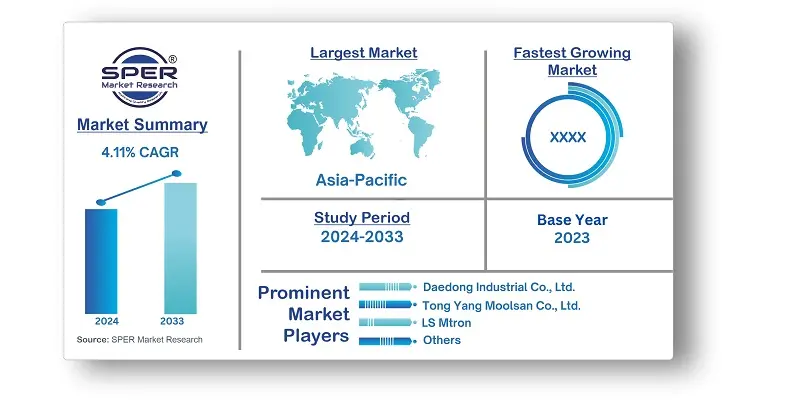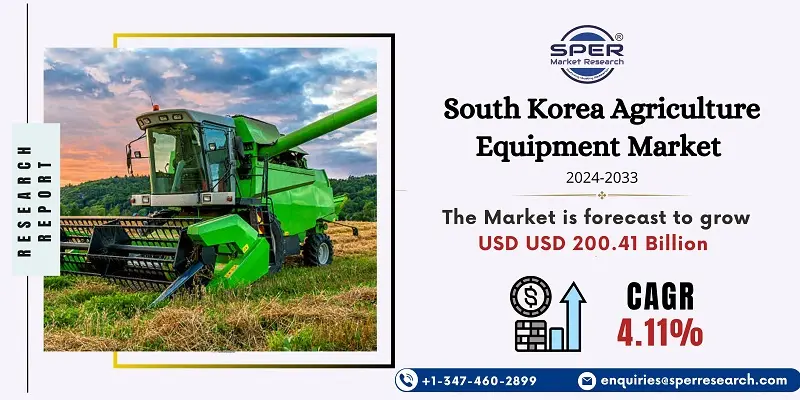
South Korea Agriculture Equipment Market Growth, Size, Trends, Demand and Future Outlook
South Korea Agriculture Equipment Market Size- By Equipment Type, By Application, By Sale Channel- Regional Outlook, Competitive Strategies and Segment Forecast to 2033
| Published: Aug-2024 | Report ID: AGRI2438 | Pages: 1 - 109 | Formats*: |
| Category : Agriculture | |||
- January 2024; LS Mtron unveiled its newest range of intelligent tractors, which come with cutting-edge GPS and IoT capabilities. By offering automated functions and real-time data, these tractors are intended to improve resource management and productivity in precision farming.
- March 2024; To develop electric-powered agricultural gear, Daedong Industrial Co., Ltd. (KIOTI) announced a strategic alliance with a top IT company. Daedong's commitment to sustainability and lowering carbon emissions in farming operations is reflected in this effort.


| Report Metric | Details |
| Market size available for years | 2020-2033 |
| Base year considered | 2023 |
| Forecast period | 2024-2033 |
| Segments covered | By Equipment Type, By Application, By Sale Channel |
| Regions covered | Seoul Capital Area, Yeongam (Southeastern Region), Honam (Southwestern), Hoseo (central Region) |
| Companies Covered | Daedong Industrial Co., Ltd., Tong Yang Moolsan Co., Ltd., LS Mtron, Samyang Chemical Co., Ltd., Asia Agricultural Machinery Co., Ltd., Kukje Machinery Co., Ltd., Hinomoto Co., Ltd., Sungboo Industry Co., Ltd., Others. |
- Manufacturers and Suppliers
- Government Agencies and Policymakers
- Investors and Financial Institutions
- Farmers and Agricultural Cooperatives
- Research and Academic Institutions
- Industry Associations and Trade Organizations
| By Equipment Type: |
|
| By Application: |
|
| By Sales Channel: |
|
- South Korea Agriculture Equipment Market Size (FY’2024-FY’2033)
- Overview of South Korea Agriculture Equipment Market
- Segmentation of South Korea Agriculture Equipment Market by Equipment Type (Agriculture Tractor, Harvesting Equipment, Irrigation and Crop Processing Equipment, Agriculture Spraying and Handling Equipment, Soil Preparation and Cultivation Equipment)
- Segmentation of South Korea Agriculture Equipment Market by Application (Land Development, Threshing and Harvesting, Plant Protection, After Agro Processing)
- Segmentation of South Korea Agriculture Equipment Market by Sales Channel (Original Equipment Manufacturers, Aftermarket)
- Statistical Snap of South Korea Agriculture Equipment Market
- Expansion Analysis of South Korea Agriculture Equipment Market
- Problems and Obstacles in South Korea Agriculture Equipment Market
- Competitive Landscape in the South Korea Agriculture Equipment Market
- Impact of COVID-19 and Demonetization on South Korea Agriculture Equipment Market
- Details on Current Investment in South Korea Agriculture Equipment Market
- Competitive Analysis of South Korea Agriculture Equipment Market
- Prominent Players in the South Korea Agriculture Equipment Market
- SWOT Analysis of South Korea Agriculture Equipment Market
- South Korea Agriculture Equipment Market Future Outlook and Projections (FY’2024-FY’2033)
- Recommendations from Analyst
1.1. Scope of the report1.2. Market segment analysis
2.1. Research data source2.1.1. Secondary Data2.1.2. Primary Data2.1.3. SPER’s internal database2.1.4. Premium insight from KOL’s2.2. Market size estimation2.2.1. Top-down and Bottom-up approach2.3. Data triangulation
4.1. Driver, Restraint, Opportunity and Challenges analysis4.1.1. Drivers4.1.2. Restraints4.1.3. Opportunities4.1.4. Challenges4.2. COVID-19 Impacts of the South Korea Agriculture Equipment Market.
5.1. SWOT Analysis5.1.1. Strengths5.1.2. Weaknesses5.1.3. Opportunities5.1.4. Threats5.2. PESTEL Analysis5.2.1. Political Landscape5.2.2. Economic Landscape5.2.3. Social Landscape5.2.4. Technological Landscape5.2.5. Environmental Landscape5.2.6. Legal Landscape5.3. PORTER’s Five Forces5.3.1. Bargaining power of suppliers5.3.2. Bargaining power of buyers5.3.3. Threat of Substitute5.3.4. Threat of new entrant5.3.5. Competitive rivalry5.4. Heat Map Analysis
6.1. South Korea Agriculture Equipment Market Manufacturing Base Distribution, Sales Area, Product Type6.2. Mergers & Acquisitions, Partnerships, Product Launch, and Collaboration in South Korea Agriculture Equipment Market
7.1. South Korea Agriculture Equipment Market Size, Share and Forecast, By Equipment Type, 2020-20267.2. South Korea Agriculture Equipment Market Size, Share and Forecast, By Equipment Type, 2027-20337.3. Agriculture Tractor7.4. Harvesting Equipment7.5. Irrigation and Crop Processing Equipment7.6. Agriculture Spraying and Handling Equipment7.7. Soil Preparation and Cultivation Equipment
8.1. South Korea Agriculture Equipment Market Size, Share and Forecast, By Application, 2020-20268.2. South Korea Agriculture Equipment Market Size, Share and Forecast, By Application, 2027-20338.3. Land Development8.4. Threshing and Harvesting8.5. Plant Protection8.6. After Agro Processing
9.1. South Korea Agriculture Equipment Market Size, Share and Forecast, By Sales Channel, 2020-20269.2. South Korea Agriculture Equipment Market Size, Share and Forecast, By Sales Channel, 2027-20339.3. Original Equipment Manufacturers9.4. Aftermarket
10.1. South Korea Agriculture Equipment Market Size and Market Share
11.1. South Korea Agriculture Equipment Market Size and Market Share By Region (2020-2026)11.2. South Korea Agriculture Equipment Market Size and Market Share By Region (2027-2033)
11.2.1. Seoul Capital Area11.2.2. Yeongam (Southeastern Region)11.2.3. Honam (Southwestern)11.2.4. Hoseo (central Region)
12.1. Daedong Industrial Co., Ltd.12.1.1. Company details12.1.2. Financial outlook12.1.3. Product summary12.1.4. Recent developments12.2. Tong Yang Moolsan Co., Ltd.12.2.1. Company details12.2.2. Financial outlook12.2.3. Product summary12.2.4. Recent developments12.3. LS Mtron12.3.1. Company details12.3.2. Financial outlook12.3.3. Product summary12.3.4. Recent developments12.4. Samyang Chemical Co., Ltd.12.4.1. Company details12.4.2. Financial outlook12.4.3. Product summary12.4.4. Recent developments12.5. Asia Agricultural Machinery Co., Ltd.12.5.1. Company details12.5.2. Financial outlook12.5.3. Product summary12.5.4. Recent developments12.6. Kukje Machinery Co., Ltd.12.6.1. Company details12.6.2. Financial outlook12.6.3. Product summary12.6.4. Recent developments12.7. Hinomoto Co., Ltd.12.7.1. Company details12.7.2. Financial outlook12.7.3. Product summary12.7.4. Recent developments12.8. Sungboo Industry Co., Ltd.12.8.1. Company details12.8.2. Financial outlook12.8.3. Product summary12.9. Others
SPER Market Research’s methodology uses great emphasis on primary research to ensure that the market intelligence insights are up to date, reliable and accurate. Primary interviews are done with players involved in each phase of a supply chain to analyze the market forecasting. The secondary research method is used to help you fully understand how the future markets and the spending patterns look likes.
The report is based on in-depth qualitative and quantitative analysis of the Product Market. The quantitative analysis involves the application of various projection and sampling techniques. The qualitative analysis involves primary interviews, surveys, and vendor briefings. The data gathered as a result of these processes are validated through experts opinion. Our research methodology entails an ideal mixture of primary and secondary initiatives.



Frequently Asked Questions About This Report
PLACE AN ORDER
Year End Discount
Sample Report
Pre-Purchase Inquiry
NEED CUSTOMIZATION?
Request CustomizationCALL OR EMAIL US
100% Secure Payment






Related Reports
Our Global Clients
Our data-driven insights have influenced the strategy of 200+ reputed companies across the globe.




















